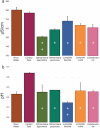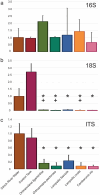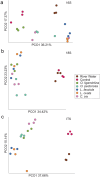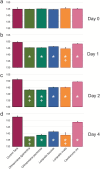Freshwater mussels prefer a diet of stramenopiles and fungi over bacteria
- PMID: 38796489
- PMCID: PMC11127930
- DOI: 10.1038/s41598-024-62245-2
Freshwater mussels prefer a diet of stramenopiles and fungi over bacteria
Abstract
Freshwater mussels (Mollusca: Unionidae) play a crucial role in freshwater river environments where they live in multi-species aggregations and often serve as long-lived benthic ecosystem engineers. Many of these species are imperiled and it is imperative that we understand their basic needs to aid in the reestablishment and maintenance of mussel beds in rivers. In an effort to expand our knowledge of the diet of these organisms, five species of mussel were introduced into enclosed systems in two experiments. In the first, mussels were incubated in water from the Clinch River (Virginia, USA) and in the second, water from a manmade pond at the Commonwealth of Virginia's Aquatic Wildlife Conservation Center in Marion, VA. Quantitative PCR and eDNA metabarcoding were used to determine which planktonic microbes were present before and after the introduction of mussels into each experimental system. It was found that all five species preferentially consumed microeukaryotes over bacteria. Most microeukaryotic taxa, including Stramenopiles and Chlorophytes were quickly consumed by all five mussel species. We also found that they consumed fungi but not as quickly as the microalgae, and that one species of mussel, Ortmanniana pectorosa, consumed bacteria but only after preferred food sources were depleted. Our results provide evidence that siphon feeding Unionid mussels can select preferred microbes from mixed plankton, and mussel species exhibit dietary niche differentiation.
© 2024. The Author(s).
Conflict of interest statement
The authors declare no competing interests.
Figures








Similar articles
-
Molecular identity crisis: environmental DNA metabarcoding meets traditional taxonomy-assessing biodiversity and freshwater mussel populations (Unionidae) in Alabama.PeerJ. 2023 Apr 3;11:e15127. doi: 10.7717/peerj.15127. eCollection 2023. PeerJ. 2023. PMID: 37033728 Free PMC article.
-
Freshwater Mussels Show Elevated Viral Richness and Intensity during a Mortality Event.Viruses. 2022 Nov 23;14(12):2603. doi: 10.3390/v14122603. Viruses. 2022. PMID: 36560607 Free PMC article.
-
Freshwater unionid mussels threatened by predation of Round Goby (Neogobius melanostomus).Sci Rep. 2022 Jul 27;12(1):12859. doi: 10.1038/s41598-022-16385-y. Sci Rep. 2022. PMID: 35896697 Free PMC article.
-
Pathology and infectious agents of unionid mussels: A primer for pathologists in disease surveillance and investigation of mortality events.Vet Pathol. 2023 Sep;60(5):510-528. doi: 10.1177/03009858231171666. Epub 2023 May 25. Vet Pathol. 2023. PMID: 37226493 Review.
-
A test of the loose-equilibrium concept with long-lived organisms: Evaluating temporal change in freshwater mussel assemblages.J Anim Ecol. 2024 Mar;93(3):281-293. doi: 10.1111/1365-2656.14046. Epub 2024 Jan 19. J Anim Ecol. 2024. PMID: 38243658 Review.
Cited by
-
Microeukaryotes Associated with Freshwater Mussels in Rivers of the Southeastern United States.Microorganisms. 2024 Sep 5;12(9):1835. doi: 10.3390/microorganisms12091835. Microorganisms. 2024. PMID: 39338509 Free PMC article.
References
-
- Williams JD, et al. A revised list of the freshwater mussels (Mollusca: Bivalvia: Unionida) of the United States and Canada. Freshw. Mollusk Biol. Conserv. 2017;20:33–58. doi: 10.31931/fmbc.v20i2.2017.33-58. - DOI
-
- Ricciardi A, Neves RJ, Rasmussen JB. Impending extinctions of North America freshwater mussels (Unionoida) following the zebra mussel (Dreissena polymorpha) invasion. J. Anim. Ecol. 1998;67:613–619. doi: 10.1046/j.1365-2656.1998.00220.x. - DOI
MeSH terms
Grants and funding
LinkOut - more resources
Full Text Sources
Medical

